JEWISH DIASPORA, CREATION OF JUDAISM AND JEWS IN THE MIDDLE AGES
JEWISH DIASPORA
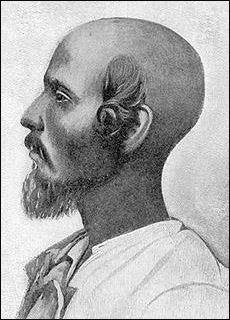
Cochin Jew in India in the 1800s After the destruction of the Jewish temple in A.D. 70 and the banishment of the Jews from Jerusalem in A.D. 135 , Jews began dispersing around the world. Many Jews lived in isolated groups that often had little or no contact with other Jewish groups. The groups were held together by religious tradition and by faith in a common calling and destiny. This cohesion and fragmentation allowed Jews around the globe to develop as community that was both national and international at the same time.
The Diaspora is a word used to describe the dispersal of Jews around the world after the destruction of the Jewish temple in A.D. 70. During the Roman period Jews began moving out of Palestinian to places like Alexandria and Rome. Most Jews settled in North Africa and the Mediterranean area. Within a few decades between 3 and 6 million Jews lived outside of Palestine in the Roman Empire and only about half that number lived in Palestine.
Alexandria was a center of Christian and Jewish learning as well Greek learning. One of the greatest achievements of the Alexandria Library and learning center was The creation of the Old Testament by seventy-two Jewish scholars, brought together by Ptolemy, to translate the Hebrew Bible (the Torah), "which from its beginning was enshrouded in legend and folklore," into Greek. According to a Jewish legend, Ptolemy asked each of the Jewish scholars to individually to translate the whole Hebrew bible, and miraculously, the result, was 72 identical versions. Modern copies of the Bible are all based on the Greek translation.
After being kicked out Palestine, the Jews lost hope of establishing a Holy Jewish empire. Instead they concentrated on surviving in the their new worlds. Some Jews remained in Palestine and lived there while numerous rulers came and went.
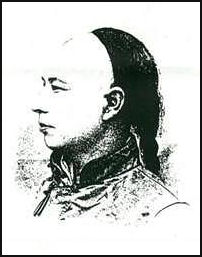
Kaifeng Jew in China 1910sJews refer to their period of exile as the Galut . During the entire time they kept alive hopes of returning to Zion, the traditional name of Jerusalem. This longing was kept alive with expression, “Next year Jerusalem," often expressed at end of Passover.
Websites and Resources: Judaism101 jewfaq.org ; Judaism and Jewish Resourcesshamash.org/trb/judaism ; Aish.com aish.com ; Wikipedia article Wikipedia ; torah?org torah.org; Chabad,org chabad.org/library/bible ; Religious Tolerance religioustolerance.org/judaism ; Judaism.com judaism.com ; ; Jewish History: Jewish History Timelinejewishhistory.org.il/history ; Wikipedia article on Wikipedia ; Jewish History Resource Centerdinur.org ; Origin of Judaism adath-shalom.ca ;Center for Jewish History cjh.org ; Jewish Culture and History Resources ddickerson.igc.org/judaica ;
Books: A Short History of Judaism by I. And D. Cohn-Sherlok (1994); The Gift of the Jews by Thomas Cahill; Ancient Biblical History Books: Egypt, Canaan and Israel in Ancient Times by Donald Redford; Oxford Companion to the Bible ; Palestine Bible as History by Werner Keller;The Bible Unearthed by I. Finkelstein & N. Asher Silberman ; Historical Atlas of the Holy Landsby K. Farrington
Websites and Resources with Torah and Biblical Images: Bible in Pictures creationism.org/books ; Bible Picture gallerybiblepicturegallery.com ; ebibleteacher ebibleteacher.com ; Bible-History.com bible-history.com ; Visual Bible Alivevisualbiblealive.com ; Pictures from Bible lavistachurchofchrist.org ; Bible Pictures karenswhimsy.com/bible-pictures ; Blue Letter Images blueletterbible.org/images ; Biblical Images preceptaustin.org
Dispersed Jews in the Roman Empire
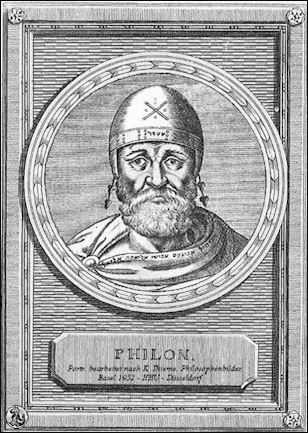
Philo of Alexandria, a great
Jewish scholar in Roman times The relations between Romans and Jews scattered through the cities of the Roman Empire were less than cordial. Anti-Semitism was a common feature of Roman life. Under Hadrian, Jews who gazed on the ruins of the Temple faced a punishment of death. Constantine allowed wailing there once a year.
The Romans demanded that their gods be worshipped, but at the same time they received the local gods. The reason the Jews and Christian were persecuted is that they presented a threat and refused to worship the Roman gods. Judaism and Christianity were not the only religions in the Roman empire. Mithraism, Manichaeism, Gnosticism and many others were practiced. There were lots of other strange religions around--- Manichaeans, Donatist, Pelagians, Arians. Subjects from all religions were expected to make sacrifices to the Roman gods and worship the Roman emperor as a god.
As the Christian religion grew, Jewish Christian converts worked to convince the Romans that their religion was different from militant Judaism. As time went on, the Romans were absolved of any guilt involving Jesus's death and the blame was placed on the Jews who handed him over to the Romans.
Some of the Jews in Italy were probably descendants of 5,000 captive Jews the Emperor Titus brought to Italy after the destruction of the Second Temple. But most are thought to have settled even before that because of the importance of Israel as a maritime trading center. A headstone of a grave found in Italy, dated to A.D. 1st century, thought to belong to a 25-year-old female, Jewish household slave reads: “Claudia Aster, captive of Jerusalem. Tiberius Claudius Proculus, imperial freeman, took care of the epitaph. I make sure through the law that you take care that no one casts down my inscription."
Jews in Middle Ages
During the Middle Ages, most Jews lived in Christian Europe. Over time the Jews spread into central and western Europe, especially Spain. After the Norman conquests, they reached England Some immigrated eastward into Asia. Babylon became an important Jewish center. Yemen was actually a Jewish kingdom for much of the 5th and 6th centuries. Small communities reached India and China. Their migration around the world help set up trade and communications links between isolated and far flung places.

Synagogues in Antiquity
Jews were massacred or expelled as part the crusades movement. When Jerusalem was taken in 1099, the banner of Christ was raised above the Temple Mount and Jews were driven into synagogues and burnt. Corpses were reported to be knee-high and bood flowed down the Valley of Kidorn. William of Tyre wrote, "I roused horror in all who looked upon [it]. Muslims and Jews that survived were captured and sold into slavery. During 87 years of Crusader rule Jerusalem Judaism was banned.
In the 9th century the Khazars, a Turkic tribe in Russia, converted en masse to Judaism. The Khazar Khan Turk Bulan underwent a ritual circumcision. Some say the conversion was as much of political move by the Khazars---to distance themselves from the Christian Byzantines and Muslim Arabs---as a religious one. Some attribute the Khazar's conversion to the influence of the people that became known as Mountain Jews of the Caucasus. There were many Jewish aristocrats, merchants and advisors from the Caucasus in the Khazar court before the Khazars converted.
As for Judaism itself, the Middle Ages were a time when the laws generated in the Biblical and rabbinic period were interpreted and Jews sought to understand their meanings. The process was similar to what occurred in Italy during the Renaissance, when Greek philosophy was rediscovered and applied with rigorousness and enthusiasm. Reasoning and providing rational proof were the objective with Aristotelean thought providing a primary model over the neo-Platonists.
It has been argued that the Middle Ages for Jews continued into the 18th century because persecution and isolation kept them from enjoying the fruits of the Renaissance and the enlightenment.

French Jews in the 18th century
Jews in Medieval Europe
Most Jews in Medieval Europe lived in segregated ghettos in the fortified towns. They spoke local languages although they often wrote it using Hebrew letters and made their living like most Christians as craftsmen. Because making money from interest was viewed as a sin by most Christians many Jews were also employed as moneychangers, pawnbrokers and moneylenders. Jews were not restricted from charging high interest by church rules against usury. Moneylenders sometimes charged interest rates as high as 40 percent a year.
Jews were protected the same laws as Christians and Pope Innocent III ruled "no one shall disturb them by beating them with clubs" or exhuming their bodies from Jewish cemeteries. Occasionally, however, Jews were expelled from towns by greedy lords so their goods were seized. As a consequence the Jewish moneylenders often charged high interest rates to cover the risks of simply being a Jew. ["Life in a Medieval City" by Joseph and Frances Gies, Harper Perennial]
Many Jews also also doctors. Medieval medicine was essentially Greek medicine introduced by way of Arabs texts through Spain. Since more Jews understood Arabic than Christians, they were believed to more knowledgeable about medicine. [Ibid]

Cochin Jews in India
Services in synagogues were more casual than the services in the Christian churches. People wandered in and out, children ran around. Their were fines for striking other worshippers during a service. Jews were required to attend services during the Sabbath and many came everyday to read scriptures and light wax candles. [Ibid]
The Jews were welcomed by feudal lords because of the knowledge of trade and science. They rose to high positions and established themselves as doctors, bankers and merchants in the Court of Charlemagne and began settling France and the Rhineland in the 8th century, and among the Moors in Spain.
Jews in the Mediterranean in Middle Ages
The were large Jewish communities in southern Spain, southern Italy and Sicily around Venice, Verona, Naples and Syracuse and southern France in Provence. The Jew sin southern Italy are believed to be the ancestors of the earliest Jewish settlers in northern and eastern Europe.

French Jews in the 18th century
Jews played a vital role in trade in the Mediterranean. By the end of the A.D. 4th century they dominated commerce in many towns and were even important political and community leaders. The Jews in Italy seem to have been fairly well assimilated and spoke largely Latin and Greek. Indications of their wealth include land records of large, luxurious villas owned by Jews, elaborate ritual baths and catacombs with artwork painted in gold.
The Black Death of 1348 was blamed on the Jews. Looking for scapegoats, Europeans massacred Jews, suspected of poisoning the water. In Geneva Jews were tortured until they confessed to poisoning wells.When news of this spread around Europe Jews were forced to into house were they either starved to death or had their houses set on fire. Across Germany the Flagellants slaughtered thousands of Jews.
Creation of Judaism
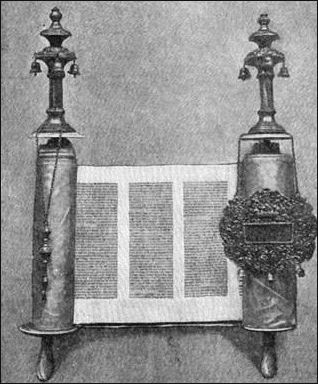 The evolution from Hebraism (a religion based only on the scriptures of the Old Testament) to Judaism (with rabbis and religion doctrine interpreted by these rabbis) was a slow transformation that began in the destruction of the Second Temple (A.D. 70) and the compilation of the Mishnah (Judaism's first major canonical document following the Bible) in the A.D. second century. During this time Judaism absorbed new ideas and faced new problems, many resulting from war and dislocation.
The evolution from Hebraism (a religion based only on the scriptures of the Old Testament) to Judaism (with rabbis and religion doctrine interpreted by these rabbis) was a slow transformation that began in the destruction of the Second Temple (A.D. 70) and the compilation of the Mishnah (Judaism's first major canonical document following the Bible) in the A.D. second century. During this time Judaism absorbed new ideas and faced new problems, many resulting from war and dislocation.
Alexandria was a center of Jewish intellectual life as well as Greek, Roman and Christian intellectual thought. Jewish scholars such as Philo of Alexandria were deeply influenced by Greek philosophy, which helped them find a vocabulary and ideas to address some of the more abstract concepts of their religion especially when it came to God. By contrast scholars that stayed close to their roots in Palestine stayed truer to the Bible and conceptualized God in more human and anthropomorphic terms. The evolution of these two methods of approaching Judaism led to articulation of the more mysterious aspects of Judaism and a codification of its laws.
The creation of Judaism was the work of rabbis who reconstructed the religion of the Jews by interpreting the Torah in a world without a Temple based on oral traditions, families and synagogues. The record of these rabbis formed the basis for the Mishnah and the Talmud.
In the Middle Ages there were many Jewish sects. In some cases each had its own Talmud. In time the the Babylonian Talmud predominated over the others. These were later organized into codes of which the code of Maimonides (1135-1204) and Joseph Caro (1488-1575), known as Shulchan Aruch , became the most important.
Maimonides and Other Jewish Philosophers
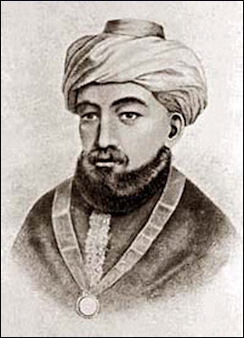
Maimonides Moses Maimonides (1135-1204) is regarded as the greatest Torah scholar, the most important medieval Jewish philosopher and the most influential rationalist thinker of Judaism. He is the author of The Guide to the Perplexed and the Thirteen Articles of Faith and the source of many Talmudist and Rabbinic laws. Both Maimonides and the Muslim philosopher and scientist Averroes were born in the Spanish city of Cordova and it is said that they became good friends.
Maimonides was a physicians and polymath. He advocated rationalism and was an admirer of Greek philosophy. He was both a clever Aristotlean thinker and believer that all fundamental truths can be found in the Torah . His ideas however were quite controversial and split Judaism into two camps.
The Thirteen Articles of Faith of Maimonides are regarded as the basic dogma of Judaism. They are: 1) The existence of God, the Creator of All Things; 2) His absolute unity; 3) His incorporeality; 4) His eternity; 5) The obligation to serve and worship him alone; 6) The existence of prophecy; 7) The superiority of the Prophecy of Moses above all others; 8) The Torah is God's revelation to Moses; 9) The Torah is immutable; 10) God's omniscience and foreknowledge; 11) Rewards and punishments according to one's deeds; 12) The coming of the Messiah; 13) The resurrection of the dead.
Bahya ibn Pakuda (Spain,11th century) was another famous Jewish thinker. In his book Duties of the Heart he espoused asceticism, denounced giving into one's desires and developed a kind of Jewish Sufism and brought it to a large audience.
There was a famous series of theological debates between priests and rabbis in the 13th and 14th century sponsored by the Catholic church. They were a no-win situation for Jews. If they lost they lost if they won they risked being lynched by a mob. A famous duel between a Jewish convert to Christianity named Pablo Christian and Nachmanides of Girona, the most famous Talmudic scholar of his generation, took place in Barcelona in 1283. Nachmanides performed so well he was charged with blasphemy and forced to leave the country.
Yehudah Halevi
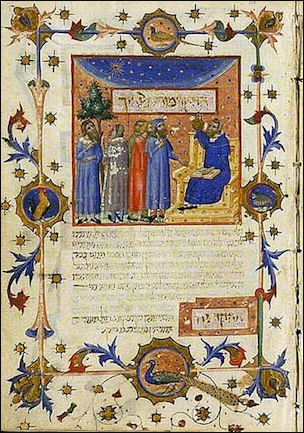
Maimonides' teaching Yehudah Halevi (1080-1141?) is a great rabbi-poet and Jewish thinker who approached Judaism from a different perspective and is also considered one of the greatest Jewish poets. Born in Spain, he spent much of life in Palestine. In his work he stressed an intense, deeply personal love of God, fealty to the Jewish community and a desire for divine communion.
Halevi was a outgoing physician and court poet. He wrote religious verse and secular poems and were liked by Jews, Christians and Muslims alike. Many of his poems dealt with spirituality, alienation and the longing for a homeland. Some of his poems, such as Ode to Zion , are still fixtures of Jewish religious services.
Halevi's philosophical book Kuzari is in the form of dialogue with the king of the Khazars. It explored things like the difference between the God of Aristotle (a bloodless abstraction) and the God of Abraham (a living god experienced through personal revelation) and reconciled reason, history, love and religion.
One Halevi poem goes: Lord Where shall I find thee? High and hidden is they place; And where shall I not fond thee? The world is full of thy glory .
Kabbalah
The Kabbalah is the name given to Jewish mystical knowledge passed down orally from generation to generation and hinted at in the Talmud. It is concerned with finding hidden meaning in the Scriptures, reaching elevated planes and ecstatic states, delving into magic, and speculating on the coming of the Messiah. Kabbalah has been compared to Sufism, Islamic mysticism. The word Kabbalah roughly means “esoteric tradition” and more precisely “what is receives," a reference to Moses receiving the laws of God at Mt. Sinai, and a word widely used on modern Israel to describe the reception desk at hotels, among other things.
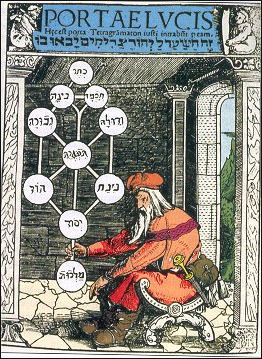
Kabbalah Tree of Life
from Medieval times Despite claims that Kabbalah is a form of mystical teaching practiced by Moses it in fact has it origins in medieval Europe. In 13th century Spain and southern France, Jewish scholars claimed they possessed secret scriptural knowledge that had originated with Moses and had been passed down orally over the centuries. These scholars and exegetes, later known as kabbalists, were focused primarily on two sections of the Torah that were forbidden by the Talmud to be discussed publically. The first is the description of Creation in Genesis and the second is a description in the Book of Ezekial of Ezekial's vison of a cosmic chariot.
The World of Emanations , a complex organization consisting of ten hierarchically-arranged sefirot (variously described as potencies, emanations, arteries. potentialities or foci), was described in the 12th century (See Below). The Zohar, Kabbalah's main text, was written in the 13th century.
Kabbalah emerged at a time when Judaism was dominated by rabbis who set rigid, detailed laws that all Jews were expected to follow unquestioningly. Judaism at that time was based in moral rationalism and included a code of ethics. It emphasized the primacy of charity and discredited esoteric beliefs and pursuing deep issues such as the meaning of God. Kabbalists sought not only to define and characterize God but also to tap into his spiritual and cosmological power, a pursuit regarded by purists as heretical.
Kabbalists first scrutinized non-Kabbalist Jewish texts and came up with elaborate and complex models of the cosmos based on interpretations of these texts. They described the kingdom of heaven and how humans could transcend their own being and “face God in his glory."
See Separate Section on the Kabbalah
Jews Under Muslim Rule
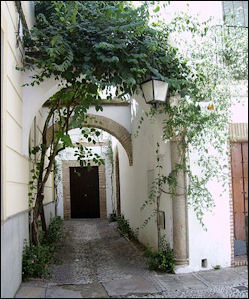
Maimonides house
in Cordoba Spain Right after the Muslim-Arab conquest most Jews in the Muslim world were farmers. Over time they became urbanites, many specializing in crafts and trade and living primarily in Jewish quarters in major cities or market towns. The Jews generally prospered during the Umayyad and Abbasid periods and endured the invasions by Turks, Crusaders and Mongols. In the 15th and 16th centuries many Jews kicked out of Spain and Sicily found new homes in the Middle East. Under colonialism, Jews thrived as traders and intermediaries.
Under Muslim rule Jews were designated by Muslim law as dhimmi and tolerated and permitted to practice their own religion but liable to pay special taxes, denied political and legal rights granted to Muslims and control by Muslim “patrons," who subjected Jews to special laws that kept them in a position inferior to Muslims. The fate of the Jews in the Middle East depended largely how they were treated by their Arab and Ottoman overlords.
Because the Jews were prohibited from owning land and feared being robbed and because there were no banks, Jews often engaged in moneylending as a way of disposing their excess cash. Many worked at jobs withing the Jewish community such as religion leaders, butchers and ritual slaughters. Others worked as masons, druggists, doctors and liquor and carpet merchants.
After the Arab-Muslim conquest a number of messianic movements arose in Jewish communities. These movements sometimes led to riots and persecution. Arab-Muslim rule was sometimes quite tolerant and this sometimes led to the sprouting of new sects such as the Karaites.
Jews Under Ottoman Rule

Greek Jewish Rabbi Under the Ottomans, Jews, Christians and other “protected” minorities were obliged to follow Ottoman law and keep a low profile. They had to pay special taxes and could not build conspicuous places of worship and were required to show deference to Muslims. In return minority communities were given considerable autonomy. For internal matters they were under the authority of religious leaders.
People of different religions and ethnic groups lived peacefully for centuries under the Ottoman rule. The historian Karen Armstrong wrote: “The sultan did not impose uniformity on his subjects nor did he try to force the disparate elements of his empire into one huge party. The government merely enabled the the different groups---Christians, Jews, Arabs, Turks, Berbers, merchants.".and trade guilds---to live together peacefully, each making its own contribution, and following its own beliefs and customs. The empire was thus a collection of communities, each which claimed the immediate loyalty of its members."
Muslim leaders have traditionally tolerated people from other faiths living in their territories. Under Islamic rule and Islamic law, Jews and Christians lived with Muslims in relative harmony, and were allowed to practice their religion and run their own affairs as long as they met certain obligations, namely paying a poll tax, which Muslims did not have to meet. In some places many, Jews had their own legal system and social services and Christians had their own religious authorities. From 1839, the Ottoman government maintained a hierarchy of “chief rabbis."
Sephardic Jews in Spain
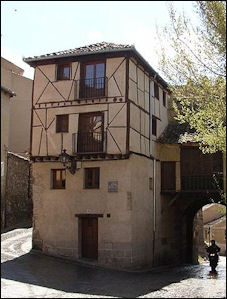
Jewish area in Segovia, Spain The Sephardic Jews associated with Spain came mostly from Spain (Sephardic is Hebrew for "of Spain") but also came from Portugal and North Africa. They spoke Ladino, a mixture of medieval Spanish and Hebrew. The arrived in Roman times after the were expelled from Jerusalem for rebelling and flourished in the Middle Ages until they were expelled in 1492.
Muslims and Jews lived together in Muslim Spain in relative harmony. Jews had their own legal system and social services but were relatively powerless. They were required to pay special taxes that Muslims didn't pay, forced to wear identifying clothing and were not allowed to open new synagogues. Jews had a strong sense of alienation and were reminded everyday in numerous ways that they were different. There was also the fear of potent waves of persecution. An anti-Jewish riot in Granada claimed 1,500 Jewish families.
Still Jews managed to prosper as craftsmen and traders. They prospered so much in fact that period between 900 and 1200 in Spain and North Africa is known as the Hebrew "golden age," when Jews inspired in part by their Arab counterparts made advances in astronomy, philosophy, science and poetry.
Image Sources: Wikimedia Commons
Text Sources: World Religions edited by Geoffrey Parrinder (Facts on File Publications, New York); Encyclopedia of the World's Religions edited by R.C. Zaehner (Barnes & Noble Books, 1959); Encyclopedia of the World Cultures edited by David Levinson (G.K. Hall & Company, New York, 1994); National Geographic, the New York Times, Washington Post, Los Angeles Times, Smithsonian magazine, Times of London, The New Yorker, Time, Newsweek, Reuters, AP, AFP, Lonely Planet Guides, Compton's Encyclopedia and various books and other publications.
No comments:
Post a Comment